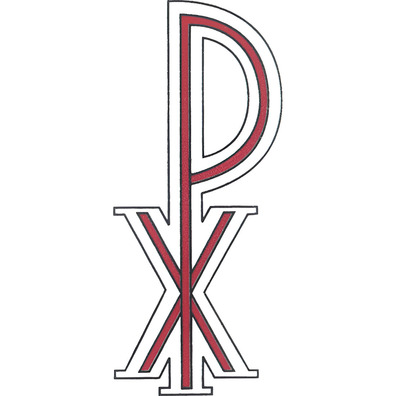Chi Ro Sticker | Chrismon | 14,5 x 5,5 cm.
1,50€
Taxes includedCatholic product in stock. Products ready to be shipped. You can check the approximate delivery time during the purchase process.
Chi Ro Sticker | Labarum | Chrismon
- Crismon sticker, also known as Christogram or Labarum.
- Self-adhesive.
- 14.5 cm (5.70 in) tall
- 5.5 cm (2.16 in) wide.
- Transparent background.
- Letters in black and red.
- Easy to apply.
- Other Chi Ro stickers available in our online store.
What is the Chrismon or Christogram? | Chi Ro Meaning
The Chrismon, or Christogram, or Chi Ro, is a Christian symbol representing Jesus Christ.
The monogram is composed of the Greek letters "Χ" (chi) and "Ρ" (rho). These represent the first two letters of "Χριστός" (Christos), which means "the anointed one."
Generally, the "P" is at the center, with the arms of the "X" crossed over it. Sometimes, the letters "Α" (alpha) and "Ω" (omega) are added, referring to Christ's words in Revelation: "I am the Alpha and the Omega, the beginning and the end" (Revelation 22:13). It represents the eternity of Christ and his role as the beginning and end of all things.
Why is it also known as the Labarum?
The Chrismon is sometimes called the Labarum. This association comes from the time of Constantine, the first Roman emperor who converted to Christianity in the 4th century.
The Labarum (in Latin: labarum-i) was originally a Greek-origin standard used by Roman emperors.
This symbol was first used by Emperor Hadrian.
Emperor Constantine, after his conversion to Christianity, modified the Labarum, replacing the Eagle of Jupiter with the Crismon or Christ monogram.
During Constantine's time, the Labarum consisted of a long spear with the Christ monogram, formed by the two Greek initials X and P (Chi and Rho) of the Greek name (χριστóς), with the last letter placed in the center of the first.
Additionally, the letters alpha and omega often appeared on each side, being the first and last letters of the Greek alphabet.
The Labarum was carried before the emperor in ceremonies where he wanted to display his imperial power, especially in times of war.



